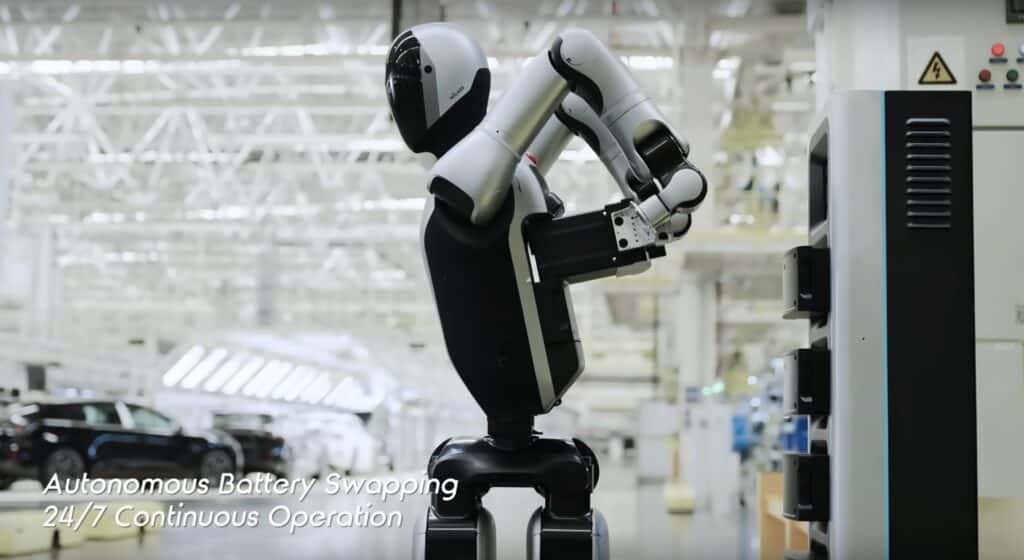The industrial robotics scene is evolving rapidly from China: UBTech’s humanoid Walker S2 can replace its own battery in just three minutes, surpassing Tesla’s model, which still requires pauses for recharging.
The landscape of industrial robotics has taken a significant leap forward with the launch of the Walker S2, a humanoid robot developed by UBTech Robotics, set to redefine productivity in factories and warehouses. Unlike Tesla’s Optimus, which needs to stop to recharge at a fixed station, the Walker S2 features an autonomous battery exchange system that allows it to operate continuously, 24/7.
Elon Musk has repeatedly claimed that Optimus will be a “trillion-dollar” business for Tesla, but competition, especially from China, is fierce. The Walker S2, an evolution of the industrial robot Walker, demonstrates that robotics require not only intelligence and mobility but also energy efficiency in real-world settings.
Technical Capabilities of Walker S2
11 degrees of freedom in each arm, enabling precise handling of delicate objects.
Travel speed of up to 2 meters per second.
Ability to kneel, rotate its torso 162°, and lift heavy objects with an incline of up to 170°.
Integrated AI based on language models, with voice control and human-robot interaction capabilities.
These specs put it on par with Tesla’s Optimus 2 in terms of mobility and contextual intelligence.
The Key Innovation: Autonomous Battery Swapping
The real breakthrough with Walker S2 lies in its automatic battery swapping system. Unlike Tesla’s Optimus, which must walk to a charging station and stay connected, UBTech’s robot autonomously heads to a swap station, removes its depleted battery, and replaces it with a fully charged one—all in under three minutes.
This approach resembles the BaaS (Battery as a Service) model gaining popularity in China’s electric vehicle sector, where companies like NIO perform over 100,000 battery swaps daily and have surpassed 80 million swaps overall. Backed by industry giants like CATL, the world’s largest battery manufacturer, this technology is not just experimental but a cornerstone of China’s energy future.
Implications for Tesla and the Future of Industrial Robotics
While Tesla remains a leader in vertical hardware integration and AI, its Optimus proposition now appears less competitive when compared to solutions like the Walker S2, especially in environments where every minute counts.
Additionally, the interchangeable battery model could redefine collaborative robotics, turning autonomous maintenance into an integral part of the workflow. Instead of relying solely on charging stations, factories might deploy robotic swap modules, boosting operational efficiency and reducing human intervention.
Quick Comparison: Tesla Optimus vs Walker S2
| Feature | Tesla Optimus 2 | Walker S2 (UBTech) |
|---|---|---|
| Energy autonomy | Traditional charging | Automatic battery exchange |
| Recharge time | Several hours | 3 minutes (battery swap) |
| Speed | ~1.5 m/sec (estimated) | 2 m/sec |
| Voice control | Yes | Yes |
| Human-robot interaction | Limited (in trials) | Developed with integrated LLM |
| Arm degrees of freedom | 11 DoF | 11 DoF |
| Applications | General use, robotaxi | Industrial robotics, logistics |
The arrival of the Walker S2 marks a turning point in the race to dominate the humanoid robot market. If Tesla intends to maintain its leading position, it will need to accelerate the development of new features in Optimus and reconsider its energy strategy toward more agile solutions like battery swapping.
Will 2025 be the year Asia takes the lead in industrial humanoid robotics? The rivalry between Musk and the Chinese tech giants has only just begun.
via: UBTech

